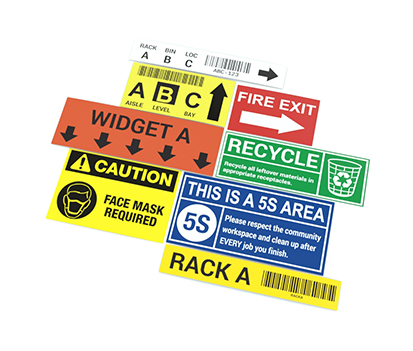
Several parts go into labeling an entire warehouse, specifically labeling inventory. When a warehouse is actively looking to implement a rack labeling system within their building, they must become familiar with the different areas that must be labeled—racks, shelves, and bins. These labeling opportunities allow for maximum inventory organization, with the main goal of assisting employees and customers with finding what they need quickly and efficiently. With that being said, all of these location labels have the same goal of the organization in mind, but each of them is used in a slightly different way.
Comparing Label Types
Rack labels, or warehouse beam labels as they are sometimes known, mark the location of shelving or a large section that contains several different products. Some operations even utilize upright labels, referred to as totem pole labels as these are color coded to tell the scanner the location and quantity of products.
As the product organization scheme is narrowed, next comes shelf labels. Also known as rows, shelf labels categorize the space spanning horizontally across a rack space. “Families” of products often live on these shelves, the nails are all together, lightbulbs—think of how they organize a hardware store with all similar products together.
Lastly, the narrowest categorization in this labeling scheme includes bin labels. This is where the customer or the employee will find the product that will be shipped or taken home to use. It's defined as a storage type within a location that contains one or more spaces for products.
The label material used for these areas can be anything that suits the needs of the facility. Some options include magnetic, removable adhesive, die-cut labels, etc. Regardless of the material, all rack, bin, and shelf labels are generally outfitted with a barcode as well as human readable letters and numbers to denote the space it occupies.
Overall, inventory management should be one of the highest priorities in a workplace besides employee safety. It helps sustain the business by ensuring a consistent supply of materials as well as preventing waste in the form of time, energy, and incorrect orders. Simply keeping everything organized with a labeling scheme will help with just that.
Similar Questions
- What are bin location labels?
- What is a rack labeling system?
- What are some different rack labeling strategies?
- What are the best way to label warehouse racks?
- What are the benefits of implementing a warehouse rack labeling system?
- Why is rack labeling important?
- What supplies are needed for implementing a rack labeling system?
- How can I Streamline Warehouse Operations with Rack Labeling?
- What is the best system to keep track of inventory?

